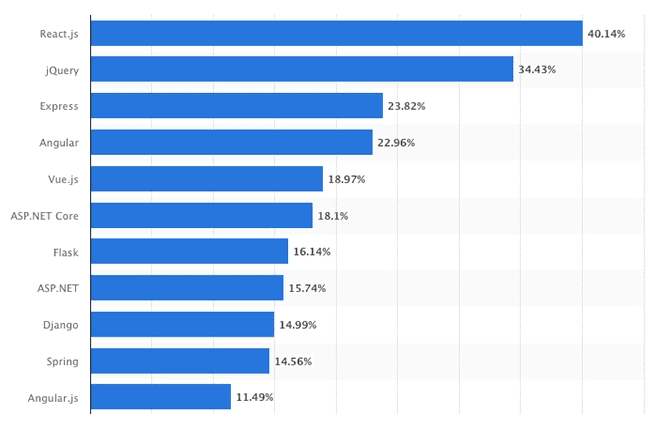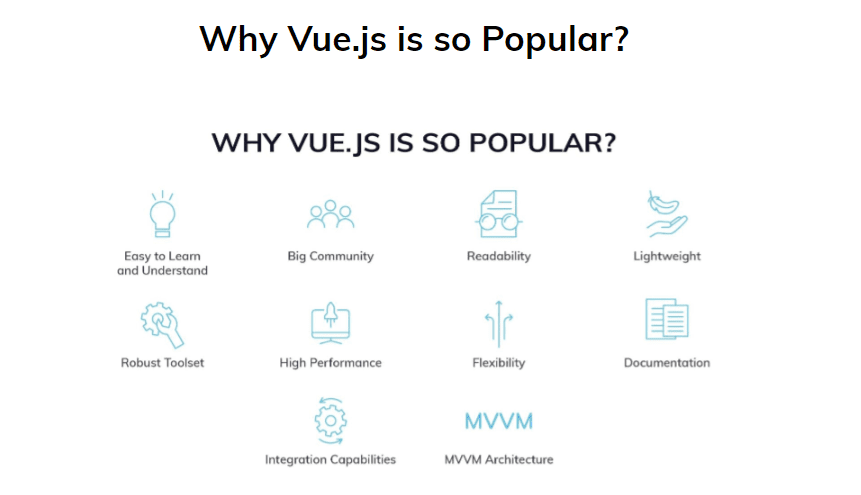Unveiling the Prowess of Vue.js: A Comprehensive Exploration Introduction to Vue.js Vue.js, a versatile and user-friendly JavaScript framework, has rapidly gained acclaim among developers for its ease of learning and flexibility in constructing interfaces and single-page applications. Garnering an impressive 197k stars on Github, Vue.js stands as a formidable contender, poised to potentially surpass React […]
Unveiling the Prowess of Vue.js: A Comprehensive Exploration
Introduction to Vue.js
Vue.js, a versatile and user-friendly JavaScript framework, has rapidly gained acclaim among developers for its ease of learning and flexibility in constructing interfaces and single-page applications. Garnering an impressive 197k stars on Github, Vue.js stands as a formidable contender, poised to potentially surpass React as the preferred JavaScript technology.
As a software development company, we hold a deep appreciation for Vue.js, attributing its appeal to the ability it provides in swiftly constructing applications due to its lightweight nature and progressive design. In this in-depth exploration, we delve into the intricacies of Vue.js, unraveling the reasons behind its widespread popularity among developers and project owners.

Why Vue.js Is So Popular in 2024
Unraveling Vue.js: A Deeper Dive
1. Easy to Learn and Understand
Vue.js owes a significant portion of its popularity to its inherent simplicity. Developers can embark on Vue.js with a fundamental knowledge of JavaScript, HTML, and CSS. Utilizing single-file documents containing various code types, such as JS, CSS, and HTML, Vue empowers developers to achieve robust functionality with minimal code, rivaling heavier frameworks like React and Angular.
2. Big Community
Unlike its counterparts, Vue relies solely on donations from sponsors and its open-source community. Statistics from surveys conducted by Statista and Stack Overflow in 2023 highlight Vue.js’s growing popularity, underscoring the vibrant engagement of its community. NPM trends further showcase the steady ascent of Vue, making it a compelling choice for developers.

Why Vue.js Is So Popular in 2024
3. Readability
Vue’s component-based architecture bestows advantages in terms of component reusability, code readability, and streamlined unit testing. With components stored in separate files, Vue makes it accessible, maintainable, and easy to fix, fostering a development environment conducive to efficient coding practices.
4. Lightweight
Vue distinguishes itself as a lightweight framework, with its minified and compressed runtime weighing approximately 20 KB. Vue 3, the latest version, is estimated to have a bundle weighing only 10 KB. This lightweight nature expedites the download and installation process, positively impacting user experience and SEO optimization.
5. Robust Toolset
Despite its relative youth, Vue boasts a powerful toolset, including a state manager, browser debugging tools, Babel support, unit testing capabilities, a server renderer, and more. This comprehensive toolkit equips developers with the necessary resources for efficient and effective application development.
6. High Performance
Vue stands out as one of the fastest frameworks for web interface development, delivering precise user experiences in both UIs and single-page applications. Notably, Vue exhibits faster launch times in mobile applications compared to React and Angular, further enhancing its appeal.
7. Flexibility
Vue.js is renowned for its flexibility, enabling developers to write and run applications directly from a browser. Its versatility in handling complex apps through bundling, routing, ES6, JSX, and components positions Vue as a preferred choice for cross-platform app development across diverse environments.
8. Model-View-ViewModel (MVVM) Architecture
Vue adopts the MVVM architecture, focusing primarily on the ViewModel layer. This architectural choice enhances the user interface by simplifying event-driven programming. The separation of the user interface from the app logic facilitates seamless updates and changes without necessitating a complete app redesign.
9. Integral Capabilities
Vue’s dependence on JavaScript empowers developers to write templates with enhanced flexibility. This characteristic enables smooth transitions to other frameworks, such as React or Angular, if required.
10. Documentation
Vue sets itself apart with meticulously crafted documentation, available in eight languages. The comprehensive documentation includes detailed code usage examples, complemented by video courses catering to a range of proficiency levels, from beginners to advanced users.
Diverse Applications of Vue.js
While Vue.js was initially designed for one-page applications and web pages, its application extends to various domains:
1. Prototypes
Vue.js originated from Evan You’s frustration with Angular while working on prototypes at Google. Its simplicity allows even designers with minimal experience to rapidly prototype using Vue.js.
2. UI Projects
Vue’s requirement of only HTML, CSS, and JS, coupled with a strong focus on UI, makes it an ideal choice for UI-centric projects.
3. Existing Applications
Vue seamlessly integrates into existing applications, making it a valuable tool for adding functionality. Its compatibility with various back-end technologies, such as Ruby on Rails, Django, and Express.js, further enhances its versatility.
4. Mobile Apps
While Vue is designed for web apps, its application extends beyond browsers. Vue supports the development of mobile apps, whether through Ionic Vue for cross-platform solutions or for native iOS, Android, and Progressive Web Apps (PWAs).
Core Attributes of Vue.js Framework
1. Virtual DOM (Documented Object Model)
Vue’s rendering system relies on a virtual representation of the actual DOM, following in the footsteps of React. This approach allows developers to programmatically create, test, and compose UI structures in a declarative manner, minimizing the need for direct DOM manipulation.
2. Data Binding
Vue’s two-way binding and Virtual DOM contribute to minimal coding efforts for developers. Changes in the Model or View layer automatically propagate throughout the application, ensuring consistent data across various components.
3. Templates
Vue’s HTML-based template syntax enables declarative binding of the rendered DOM to the underlying component instance’s data. The templates, when compiled, result in highly optimized JS code, coupled with a reactivity system that minimizes unnecessary re-renders and DOM manipulations.
4. Computed Properties
Vue.js introduces computed properties, offering a structured means for developers to create, manipulate, and display data within components. These properties facilitate tasks such as data filtering, calculations, conditional rendering, and interactions with getters.
5. Tooling and Libraries
Vue’s ecosystem is enriched with a variety of tools and libraries, enhancing the development process. Noteworthy entries include Vue CLI, Nuxt, Vuetify, VuePress, Vuex, Quasar, and Gridsome.
6. Animation and Transition
Vue provides components such as <Transition> and <TransitionGroup> to manage enter/leave and list transitions. The framework supports various animation techniques, including class-based animations, state-driven animations, and animations driven by watchers.
When to Embrace Vue.js
1. Animation and Interactive Elements
Vue’s robust data-binding makes it an excellent choice for handling animations, interactive elements, and graphics. Its flexible API and seamless transition between views offer diverse possibilities for creating captivating animations with built-in modules based on CSS animation.
2. Integration with Numerous Apps
Vue.js seamlessly integrates with both single-page and multi-page applications, making it an attractive option for projects with existing architectures.
3. Publishing an MVP
Vue.js streamlines the process of publishing a Minimum Viable Product (MVP) owing to its reusable components and templates, facilitating rapid development cycles.
Exemplary Applications and Websites Built with Vue.js
Vue.js has left an indelible mark on the web landscape, with a staggering 1,936,822 live sites utilizing its capabilities. Some notable examples include [provide a few examples here]. A comprehensive list of websites built with Vue can be explored on Github.
In Conclusion
In conclusion, Vue.js emerges as a powerhouse in the realm of frontend development, offering a plethora of advantages. While particularly well-suited for lightweight projects, its versatility shines through in various applications. Developers seeking a nimble, efficient, and developer-friendly framework will find Vue.js to be an invaluable asset. However, for large and complex websites, React may still hold the edge. If you find yourself at a crossroads in selecting the ideal tech stack for your project, or if you seek an experienced partner for development, design, and maintenance, feel free to reach out to us at inVerita. With over six years of diverse experience across industries and project scales, from startups to Fortune 500 companies, we stand ready to bring your vision to life.